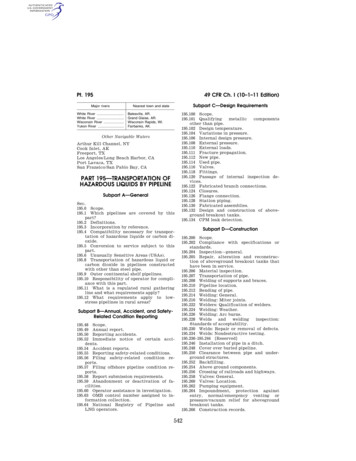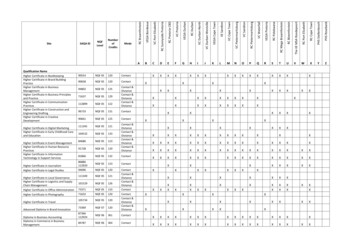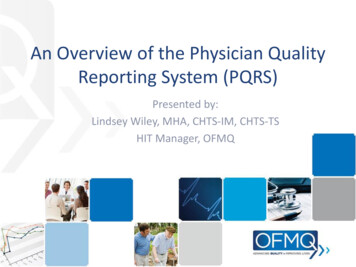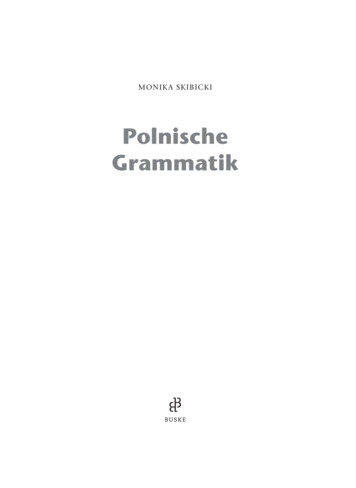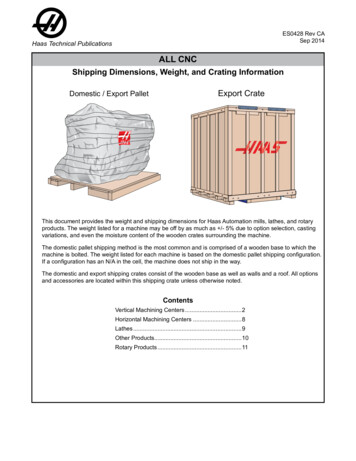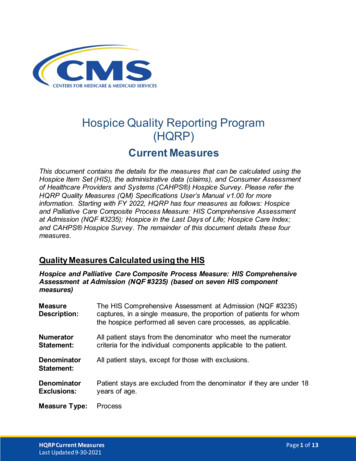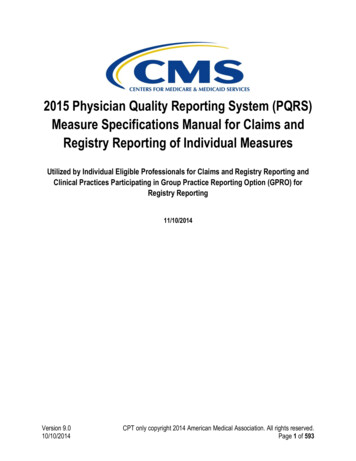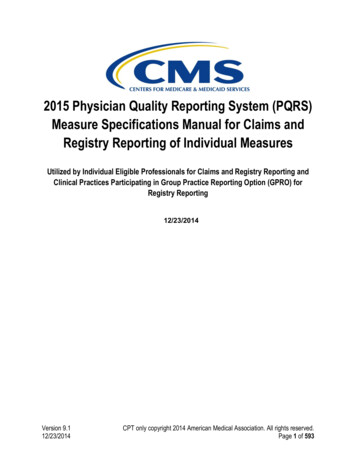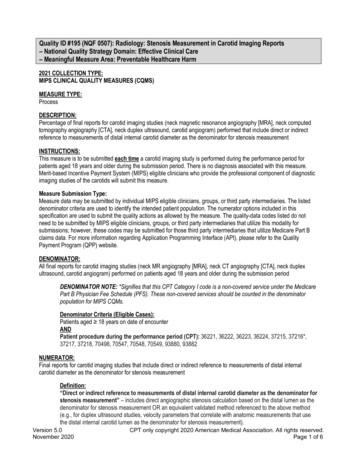
Transcription
Quality ID #195 (NQF 0507): Radiology: Stenosis Measurement in Carotid Imaging Reports– National Quality Strategy Domain: Effective Clinical Care– Meaningful Measure Area: Preventable Healthcare Harm2021 COLLECTION TYPE:MIPS CLINICAL QUALITY MEASURES (CQMS)MEASURE TYPE:ProcessDESCRIPTION:Percentage of final reports for carotid imaging studies (neck magnetic resonance angiography [MRA], neck computedtomography angiography [CTA], neck duplex ultrasound, carotid angiogram) performed that include direct or indirectreference to measurements of distal internal carotid diameter as the denominator for stenosis measurementINSTRUCTIONS:This measure is to be submitted each time a carotid imaging study is performed during the performance period forpatients aged 18 years and older during the submission period. There is no diagnosis associated with this measure.Merit-based Incentive Payment System (MIPS) eligible clinicians who provide the professional component of diagnosticimaging studies of the carotids will submit this measure.Measure Submission Type:Measure data may be submitted by individual MIPS eligible clinicians, groups, or third party intermediaries. The listeddenominator criteria are used to identify the intended patient population. The numerator options included in thisspecification are used to submit the quality actions as allowed by the measure. The quality-data codes listed do notneed to be submitted by MIPS eligible clinicians, groups, or third party intermediaries that utilize this modality forsubmissions; however, these codes may be submitted for those third party intermediaries that utilize Medicare Part Bclaims data. For more information regarding Application Programming Interface (API), please refer to the QualityPayment Program (QPP) website.DENOMINATOR:All final reports for carotid imaging studies (neck MR angiography [MRA], neck CT angiography [CTA], neck duplexultrasound, carotid angiogram) performed on patients aged 18 years and older during the submission periodDENOMINATOR NOTE: *Signifies that this CPT Category I code is a non-covered service under the MedicarePart B Physician Fee Schedule (PFS). These non-covered services should be counted in the denominatorpopulation for MIPS CQMs.Denominator Criteria (Eligible Cases):Patients aged 18 years on date of encounterANDPatient procedure during the performance period (CPT): 36221, 36222, 36223, 36224, 37215, 37216*,37217, 37218, 70498, 70547, 70548, 70549, 93880, 93882NUMERATOR:Final reports for carotid imaging studies that include direct or indirect reference to measurements of distal internalcarotid diameter as the denominator for stenosis measurementDefinition:“Direct or indirect reference to measurements of distal internal carotid diameter as the denominator forstenosis measurement” – includes direct angiographic stenosis calculation based on the distal lumen as thedenominator for stenosis measurement OR an equivalent validated method referenced to the above method(e.g., for duplex ultrasound studies, velocity parameters that correlate with anatomic measurements that usethe distal internal carotid lumen as the denominator for stenosis measurement).Version 5.0November 2020CPT only copyright 2020 American Medical Association. All rights reserved.Page 1 of 6
Numerator Instructions:This measure requires that the estimate of stenosis included in the report of the imaging study employ amethod such as the North American Symptomatic Carotid Endarterectomy Trial (NASCET) method forcalculating the degree of stenosis. The NASCET method calculates the degree of stenosis with reference tothe lumen of the carotid artery distal to the stenosis.For duplex imaging studies the reference is indirect, since the degree of stenosis is inferred from velocityparameters and cross referenced to published or self-generated correlations among velocity parameters andresults of angiography or other imaging studies which serve as the gold standard. In Doppler ultrasound, thedegree of stenosis can be estimated using Doppler parameter of the peak systolic velocity (PSV) of the internalcarotid artery (ICA), with concordance of the degree of narrowing of the ICA lumen. Additional Dopplerparameters of ICA-to-common carotid artery (CCA) PSV ratio and ICA end-diastolic velocity (EDV) can beused when degree of stenosis is uncertain from ICA PSV. (Grant et al, 2003)Measure performance is met when study methodology is identified and findings are reported as a percentageor range of percentages of carotid stenosis. Documented findings of “No Stenosis” determined throughNASCET or comparable methodology also meet measure performance. A short note can be made in the finalreport, such as: Severe left ICA stenosis of 70-80% by NASCET criteria” or “Severe left ICA stenosis of 70-80% by criteria similar to NASCET” or “70% stenosis derived by comparing the narrowest segment with the distal luminal diameter as related tothe submitted measure of arterial narrowing” or “Severe stenosis of 70-80% - validated velocity measurements with angiographic measurements, velocitycriteria are extrapolated from diameter data as defined by the Society of Radiologists in UltrasoundConsensus Conference Radiology 2003; 229;340-346”.In a small number of denominator cases the distal ICA may not be viewed e.g. an innominate artery orcommon carotid injection. Performance would be met if there is documentation, for example, that indicates“stenosis measurements are made with reference to the distal lumen”, as a matter of process and consistentpractice method.Numerator Options:Performance Met:ORPerformance Not Met:Carotid imaging study report (includes direct or indirectreference to measurements of distal internal carotiddiameter as the denominator for stenosis measurement)(3100F)Carotid imaging study report did not include direct orindirect reference to measurements of distal internalcarotid diameter as the denominator for stenosismeasurement, reason not otherwise specified(3100F with 8P)RATIONALE:Accurate assessment of the degree of carotid artery stenosis is essential to guiding proper treatment decisions forpatients with carotid artery disease. Trials have demonstrated the ability of the degree of carotid artery stenosis topredict which patients will receive the greatest benefit from surgical intervention. To ensure accurate assessment ofstenosis, it is important to use a standardized, validated approach. Rothwell et al demonstrated significant differencesbetween measurements of stenosis made using different methods of measurement.Version 5.0November 2020CPT only copyright 2020 American Medical Association. All rights reserved.Page 2 of 6
CLINICAL RECOMMENDATION STATEMENTS:The panel recommended that the NASCET method of carotid stenosis measurement should be used when angiographyis used to correlate the US findings. (SRU, 2003)When MRA techniques are used for determining carotid stenosis, the report should reflect the methodology andreference the criteria for percent stenosis outlined in the NASCET. Also, the percent stenosis must be calculated usingthe distal cervical ICA diameter, where the walls are parallel, for the denominator. Similar to CTA, MRA with attention tothe acquisition parameters and post-processing techniques can provide cross sectional measurements of stenosis thatcorrelate with properly performed NASCET estimates of percent stenosis obtained with catheter angiography. In thesetting of near occlusion, it may not be accurate to calculate percent stenosis ratios in the presence of post-stenoticarterial diameter decrease. Some MRA techniques may not be amenable to quantitative measurements, in which casequalitative assessment of stenosis should be provided. (ACR, 2010)COPYRIGHT:The Measure is not a clinical guideline, does not establish a standard of medical care, and has not been tested for allpotential applications.The Measure, while copyrighted, can be reproduced and distributed, without modification, for noncommercial purposes,e.g., use by health care providers in connection with their practices. Commercial use is defined as the sale, license, ordistribution of the Measure for commercial gain, or incorporation of the Measure into a product or service that is sold,licensed or distributed for commercial gain.Commercial uses of the Measure require a license agreement between the user and the American College of Radiology(ACR). Neither ACR nor its members shall be responsible for any use of the Measure.The PCPI’s and AMA’s significant past efforts and contributions to the development and updating of the Measures areacknowledged. ACR is solely responsible for the review and enhancement (“Maintenance”) of the Measure as of August 1,2020.ACR encourages use of the Measure by other health care professionals, where appropriate.THE MEASURE AND SPECIFICATIONS ARE PROVIDED "AS IS" WITHOUT WARRANTY OF ANY KIND. 2020 American College of Radiology. All Rights Reserved. Applicable FARS/DFARS Restrictions Apply to GovernmentUse.Limited proprietary coding may be contained in the Measure specifications for convenience. A license agreement must beentered prior to a third party’s use of Current Procedural Terminology (CPT ) or other proprietary code set contained in theMeasures. Any other use of CPT or other coding by the third party is strictly prohibited. ACR and its members disclaim allliability for use or accuracy of any CPT or other coding contained in the specifications.CPT contained in the Measures specifications is copyright 2004-2020 American Medical Association. LOINC copyright2004-2020 Regenstrief Institute, Inc. SNOMED CLINICAL TERMS (SNOMED CT ) copyright 2004-2020. TheInternational Health Terminology Standards Development Organisation (IHTSDO). ICD-10 is copyright 2020 World HealthOrganization. All Rights Reserved.Version 5.0November 2020CPT only copyright 2020 American Medical Association. All rights reserved.Page 3 of 6
2021 Clinical Quality Measure Flow for Quality ID #195 (NQF 0507):Radiology: Stenosis Measurement in Carotid Imaging ReportsDisclaimer: Refer to the measure specification for specific coding and instructions to submit this measure.DenominatorNumeratorStartPatientsaged 18 years ondate of encounterNoCarotid imagingstudy report (includesdirect or indirect reference tomeasurements of distal internalcarotid diameter as thedenominator for stenosismeasurement)YesData Completeness Met Performance Met3100F or equivalent(40 procedures)aNoYesNot Included in ring theperformance periodas listed inDenominator*Carotidimaging studyreport did not include direct orindirect reference to measurementsof distal internal carotid diameter asthe denominator for stenosismeasurement, reason nototherwise specifiedYesData Completeness Met Performance Not Met3100F with 8P or equivalent(30 procedures)cYesInclude in EligiblePopulation/Denominator(80 procedures)NoData Completeness Not Metthe Quality Data Code orequivalent was not submitted(10 procedures)SAMPLE CALCULATIONSData Completeness Performance Met (a 40 procedures) Performance Not Met (c 30 procedures)Eligible Population / Denominator (d 80 procedures)Performance Rate Performance Met (a 40 procedures)Data Completeness Numerator (70 procedures) 70 procedures80 procedures 87.50%40 procedures 57.14%70 procedures*See the posted measure specification for specific coding and instructions to submit this measure.NOTE: Submission Frequency: ProcedureCPT only copyright 2020 American Medical Association. All rights reserved.The measure diagrams were developed by CMS as a supplemental resource to be usedin conjunction with the measure specifications. They should not be used alone or as asubstitution for the measure specification.v5Version 5.0November 2020CPT only copyright 2020 American Medical Association. All rights reserved.Page 4 of 6
2021 Clinical Quality Measure Flow Narrative for Quality ID #195 (NQF 0507):Radiology: Stenosis Measurement in Carotid Imaging ReportsDisclaimer: Refer to the measure specification for specific coding and instructions to submit this measure.1. Start with Denominator2. Check Patients aged greater than or equal to 18 years on date of encounter.a. If Patients aged greater than or equal to 18 years on date of encounter equals No, do not include in EligiblePopulation/Denominator. Stop processing.b. If Patients aged greater than or equal to 18 years on date of encounter equals Yes, proceed to check Patientprocedure during the performance period as listed in Denominator*.3. Patient procedure during the performance period as listed in Denominator*:a. If Patient procedure during the performance period as listed in Denominator* equals No, do not include inEligible Population/Denominator. Stop processing.b. If Patient procedure during the performance period as listed in Denominator* equals Yes, include in EligiblePopulation/Denominator.4. Denominator Population: Denominator Population is all Eligible Procedures in the Denominator. Denominator isrepresented as Denominator in the Sample Calculation listed at the end of this document. Letter dequals 80 procedures in the Sample Calculation.5. Start Numerator6. Check Carotid imaging study report (includes direct or indirect reference to measurements of distal internal carotiddiameter as the denominator for stenosis measurement):a. If Carotid imaging study report (includes direct or indirect reference to measurements of distal internal carotiddiameter as the denominator for stenosis measurement) equals Yes, include in Data Completeness Met andPerformance Met. Data Completeness Met and Performance Met letter is represented in the Data Completeness andPerformance Rate in the Sample Calculation listed at the end of this document. Letter a equals 40procedures in the Sample Calculation.b. If Carotid imaging study report (includes direct or indirect reference to measurements of distal internal carotiddiameter as the denominator for stenosis measurement) equals No, proceed to check Carotid imaging studyreport did not include direct or indirect reference to measurements of distal internal carotid diameter as thedenominator for stenosis measurement, reason not otherwise specified.7. Check Carotid imaging study report did not include direct or indirect reference to measurements of distal internalcarotid diameter as the denominator for stenosis measurement, reason not otherwise specified:a. If Carotid imaging study report did not include direct or indirect reference to measurements of distal internalcarotid diameter as the denominator for stenosis measurement, reason not otherwise specified equals Yes,include in Data Completeness Met and Performance Not Met. Version 5.0November 2020Data Completeness Met and Performance Not Met letter is represented in the Data Completenessin the Sample Calculation listed at the end of this document. Letter c equals 30 procedures in theCPT only copyright 2020 American Medical Association. All rights reserved.Page 5 of 6
Sample Calculation.b. If Carotid imaging study report did not include direct or indirect reference to measurements of distal internalcarotid diameter as the denominator for stenosis measurement, reason not otherwise specified equals No,proceed to check Data Completeness Not Met.8. Check Data Completeness Not Met:a. If Data Completeness Not Met, the Quality Data Code was not submitted. 10 procedures have been subtractedfrom the Data Completeness Numerator in the Sample Calculation.Sample CalculationsData Completeness equals Performance Met (a equals 40 procedures) plus Performance Not Met (c equals 30 procedures)divided by Eligible Population / Denominator (d equals 80 procedures). All equals 70 procedures divided by 80 procedures.All equals 87.50 percent.Performance Rate equals Performance Met (a equals 40 procedures) divided by Data Completeness Numerator (70procedures). All equals 40 procedures divided by 70 procedures. All equals 57.14 percent.*See the posted measure specification for specific coding and instructions to submit this measure.NOTE: Submission Frequency: ProcedureThe measure diagrams were developed by CMS as a supplemental resource to be used in conjunction with the measure specifications. They should notbe used alone or as a substitution for the measure specification.Version 5.0November 2020CPT only copyright 2020 American Medical Association. All rights reserved.Page 6 of 6
2021 Clinical Quality Measure Flow Narrative for Quality ID #195 (NQF 0507): Radiology: Stenosis Measurement in Carotid Imaging Reports Disclaimer: Refer to the measure specification for specific coding and instructions to submit this measure. 1. Start with Denominator 2.

